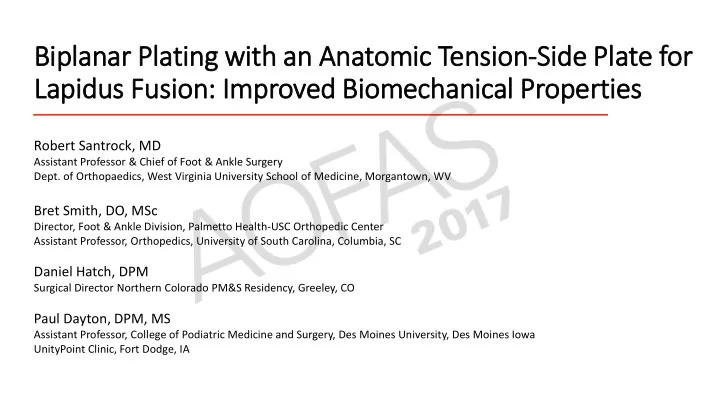

Biplanar P Plating w with a an Anatomic T c Tension on-Side P Plate f e for Lapidus us Fusion: I Improved B Biom omech echanical P Prop oper erti ties es Robert Santrock, MD Assistant Professor & Chief of Foot & Ankle Surgery Dept. of Orthopaedics, West Virginia University School of Medicine, Morgantown, WV Bret Smith, DO, MSc Director, Foot & Ankle Division, Palmetto Health-USC Orthopedic Center Assistant Professor, Orthopedics, University of South Carolina, Columbia, SC Daniel Hatch, DPM Surgical Director Northern Colorado PM&S Residency, Greeley, CO Paul Dayton, DPM, MS Assistant Professor, College of Podiatric Medicine and Surgery, Des Moines University, Des Moines Iowa UnityPoint Clinic, Fort Dodge, IA
Disclosures • Bret Smith: Treace Medical Concepts (consultant, royalty, stock ownership) • Robert Santrock: Treace Medical Concepts (consultant, royalty) • Daniel Hatch: Treace Medical Concepts (consultant, royalty, stock ownership) • Paul Dayton: Treace Medical Concepts (consultant, royalty) See final AOFAS Program for complete disclosures.
Introduction • Limitation of Lapidus fusion: Extended period of immobilization required with rigid, compression fixation • Recent AO internal fixation evolution • Advocating relative stability fixation, allowing controlled micromotion to stimulate secondary “biological” bone healing 1 • Novel relative stability Lapidus construct: Biplanar plating with two small locking plates oriented 90° (without interfrag screw) • Biomechanically tested to be superior to traditional anatomic Lapidus plate with interfrag screw in both static & cyclic loading 2 Biplanar Plating
Introduction • Tension-Side Plating Improved Stability 3 • Plantar Lapidus plate acts as tension-band to counteract bending moment of WB • Demonstrated promising initial clinical results under immediate- to-early WB 4,5 • However, plantar Lapidus plating not widely adopted due to challenges associated with surgical exposure • Novel biplanar fixation construct recently developed • Low-profile dorsal plate + anatomic medial-to-plantar plate • Application through standard dorsal incision Biplanar with Tension-Side Fixation • Biomechanical advantages of tension-side fixation • Biological healing benefits of biplanar locked plating
Purpose Determine if novel biplanar locking plate construct with tension-side fixation provides improved biomechanical stability versus previously- tested 90-90 straight biplanar construct under static and cyclic loading
Methods Two unique 2-plate fixation constructs (Treace Medical Concepts, Inc., Ponte Vedra Beach, FL) : • Both constructs fixated with 2.5mm unicortical locking screws, 12mm distally & 14mm proximally (no interfrag screw) • Bone models: 4 th generation Sawbones cuneiform & metatarsal composite 1) Straight 90-90 Biplanar Plate Construct 2) Biplanar Construct with Tension-Side Fixation Straight low-profile locking plate on dorsal surface & anatomic tension- Two straight low- profile titanium four -hole locking plates; one side locking plate wrapping from medial cuneiform to plantar surface on dorsal surface & other medial surface, 90 ° to each other. of 1st metatarsal.
Methods Mechanical Testing Protocol • Cantilever bending (30mm moment arm) on servo hydraulic materials testing machine (MTS Systems). • Two types of testing: 1. Static ultimate failure (3 pairs ea) 2. Cyclic fatigue loading (10 pairs ea) • 120N load for 1 st 50,000 cycles • Increase 25N each successive 50,000 cycles until failure or 250,000 cycles was reached Statistical analysis: Paired t-tests
Results Static Ultimate Failure Results Straight Biplanar Construct Biplanar with Tension-Side Fixation p = 0.04 Straight Biplanar Construct Failure Load (N) Biplanar with Tension-Side Fixation Static Ultimate Failure Load
Results Cyclic Fatigue Loading Results Straight Biplanar Construct Biplanar with Tension-Side Fixation * p < 0.001
Discussion • Biplanar plating with tension-side fixation significantly improves biomechanical properties over straight 90-90 biplanar plating under both static & cyclic loading • Consistent with previous biomechanical studies of tension-side Lapidus constructs 6,7 • Builds on previous biomechanical study of biplanar plating vs anatomic plate + interfrag screw construct 2 • Locked plating without a compression screw can act as an “internal external-fixator” independent, multiplanar stability provided by interlocking components • Mechanical stimulation & micromotion of early WB can promote robust “biological” secondary bone healing process via callus formation 1
Conclusion Novel construct shows promise as a practical approach to tension-side fixation for 1st TMT arthrodesis • Allows application through a standard dorsal incision • Biomechanical benefits of tension-side fixation for accelerated WB
References 1. Perren SM. Evolution of the internal fixation of long bone fractures. J.Bone Joint Surg.(Br) 84B: 1093-1110, 2002. 2. Dayton, P, Ferguson J, Hatch DJ, Santrock R, Scanlan S, Smith B. Comparison of the Mechanical Characteristics of a Universal Small Biplane Plating Technique Without Compression Screw and Single Anatomic Plate With Compression Screw. J. Foot Ankle Surg. 55:567–571, 2016. 3. Egol KA, Kubiak EN, Fulkerson E, Kummer FJ, Koval KJ. Biomechanics of locked plates and screws. J. Orthop. Trauma 18: 488–493, 2004. 4. Klos K, Wilde CH, Lange A, Wagner A, Gras F, Skulev HK, Mückley T, Simons P. Modified Lapidus arthrodesis with plantar plate and compression screw for treatment of Hallux Valgus with hypermobility of the first ray: a preliminary report. Foot Ankle Surgery 19: 239–244, 2013. 5. Gutteck N, Wohlrab D, Zeh A, Radetzki F, Delank KS, Lebek S. Comparative study of Lapidus Bunionectomy using different osteosynthesis methods. Foot Ankle Surg. 19: 218–221, 2013. 6. Klos K, Simons P, Hajduk AS, Hoffmeier KL, Gras F, Fröber R, Hofmann GO, Mückley T. Plantar versus dorsomedial locked plating for Lapidus arthrodesis: a biomechanical comparison. Foot Ankle Int. 32: 1081–1085, 2011. 7. Roth, KE, Peters J, Schmidtmann I, Maus U, Stephan D, Augat P. Intraosseous fixation compared to plantar plate fixation for first metatarsocuneiform arthrodesis: a cadaveric biomechanical analysis. Foot Ankle Int. 35: 1209–1216, 2014.
Recommend
More recommend